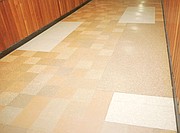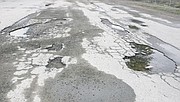School officials defend tax levy request
When voters in the Libby school district go to the polls in May to select new trustees for the school board, they will also be asked to approve a buildings maintenance levy of $4.1 million.
The levy, superintendent Craig Barringer said, is not to increase the budget for regular facility maintenance and upkeep projects, but to cover the additional expenses of larger projects required because of the age of Libby’s school buildings.
“Major renovation requires us to contract out to have the work completed because of the expertise it takes to do a project,” he said. “Typical maintenance is done by our maintenance staff throughout the year, particularly the summer. Though our staff has a great set of skills, these types of jobs are usually small projects.”
One of those major projects is the replacement of the roofs on the elementary, middle/high school and Central School. The price tags on those three projects alone exceeds $1.5 million.
“The issues of the roofs will always be a 15 to 20 year issue,” Barringer said. “And the longer we wait the more expensive it will be to replace them.”
The other two big ticket items on the schools’ list of projects are the replacement of the floor tiles in both the elementary and middle/high schools ($700,000) and the replacement of the aging heating, ventilation and air conditioning system at the elementary school (also $700,000).
The tiles in the floors of the schools are so old they can’t be matched when they require replacement. Halls in both schools are mismatched and patchy. In some areas the tile has been worn down to the point of exposing the subfloor underneath.
The HVAC system consists of 38 individual heating units, which were installed in the elementary school 46 years ago, the parts for which are no longer readily available. The elementary gymnasium has two of those heating units, only one of which is functioning because the other has been used for parts.
The levy request also includes $447,000 for outdoor repairs to the school facilities.
A culvert running under the grounds of the elementary school is a continual flood risk, said Scott Beagle, assistant principal at the elementary school. When the culvert floods, soil is washed away, exposing a concrete slab in the grass, creating a safety risk for children at play on school grounds. The cost to replace the culvert is $170,000. The remainder of the $447,000 is for resurfacing of the schools’ dilapidated parking lots and replacement of badly damaged and hazardous sidewalks, Beagle said.
The levy funds will also be used to replace aging gym floors in both schools. The current, aging floors have been sanded and refinished so many times the district can’t find a contractor willing to redo the floors and guarantee the work. There are spots in the elementary floor where the wood has buckled and bowed to the point maintenance workers have nailed or screwed the wooden planks back into place.
Other items on the school’s wish list are gymnasium and football stadium bleacher upgrades, replacement of the old, inefficient fluorescent lighting with a more efficient and less maintenance-intensive LED system and new cafeteria tables.
Barringer said the schools have worked diligently during past years to deliver quality education within the established budget constraints. The district, he said, has kept its annual budget at only 90 percent of the amount authorized by law. The budgets, he said, have been shrinking as the area’s population drops, but the maintenance demands of aging buildings continues to grow with each passing year.
The school’s 2008 budget was $8,149,148. By 2016, the district’s budget had shrunk to $7,663,144. Despite shrinking budgets, the buildings still require attention, Beagle said.
“The school district is seeking to have our buildings renewed to improve overall school climate and learning environment to promote a higher sense of school pride in our students and community,” he said. “New roofs, sidewalks, and parking lots are not improvements that are real spectacular, but are a necessity to quality education. We want to put this money into our schools now before there is all real damage to the structures. We feel if we wait any longer and have more extensive or permanent damage to the buildings we could be looking at twice as much money to repair damages.”










